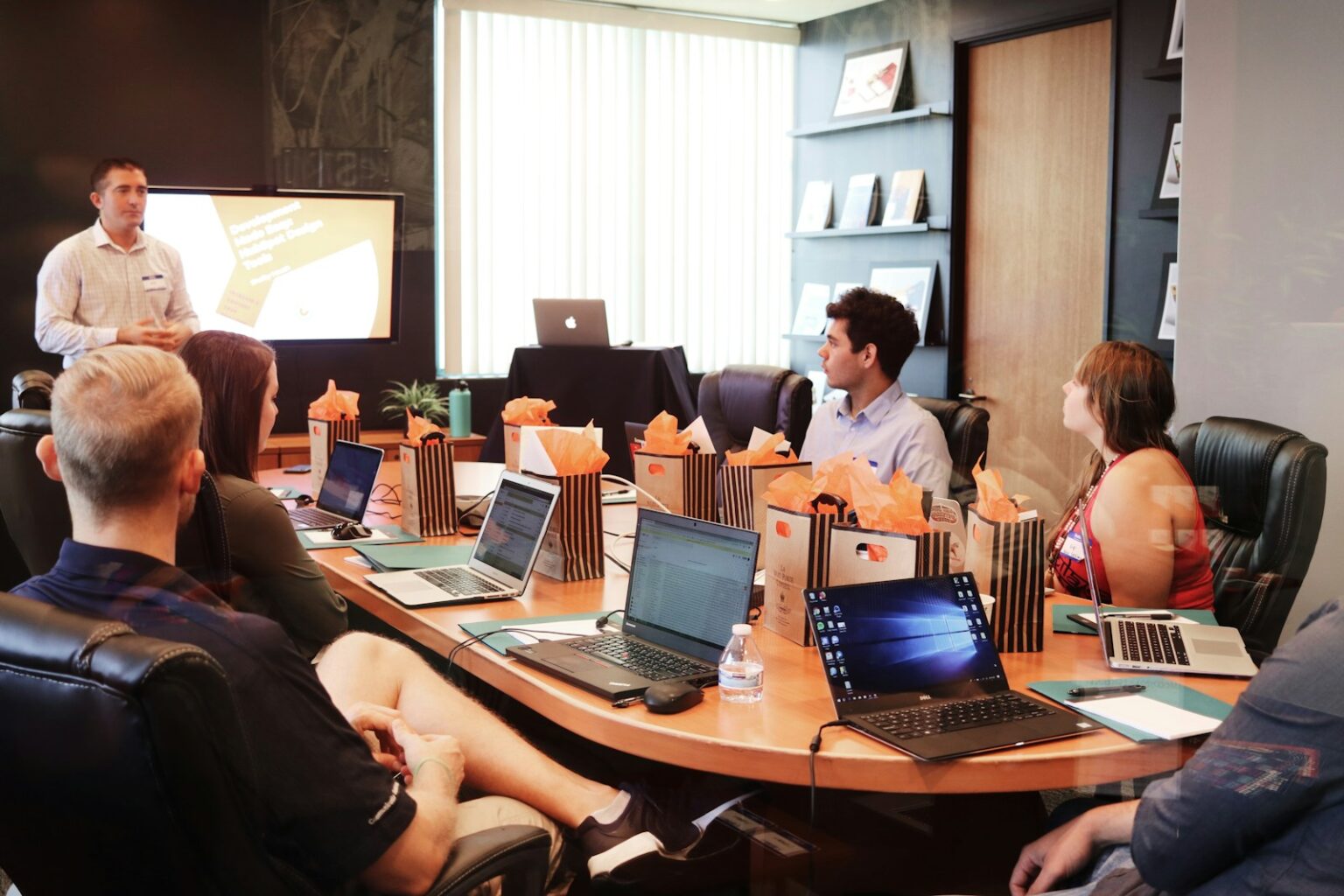When organizations spend on cybersecurity, the process is rarely simple, and that is on purpose. This overview maps the players in that purchase and shows why their joint work is the backbone of good security.
Cyber defenses go beyond shiny gear or smart software. They hinge on people, policies, and clear choices that guard sensitive assets. So when a firm considers a major security buy, the stakes soar. That purchase will touch every department and protect its crown jewels. Buying a new chair is routine; renewing a defense line is not. Because of the gap, firms convene a cross-functional panel. Colleagues from IT, finance, risk, and more sit together to guide the move.
What is a Cybersecurity Solutions Buying Committee?
Picture an organization that wants to harden its digital front. Perhaps attackers keep probing its network. Perhaps recent leaks have fed customer anxiety. Whatever the motive, the need for fresh, proven shields is clear. Yet shielding hundreds of computers, servers, and cloud nodes is too weighty for a single mind. One executive, no matter how savvy, lacks the full view. The budget is sizeable, the timeline tight, and the ripple effects huge,
Employees from marketing, IT, finance, and legal regularly meet to build a small team that will pick the firm’s next cybersecurity tool. They review product demo videos, scan analyst scores, write down risks attached to each option, and sit down with purchasing to make sure nothing slips past the budget. Later they map each choice against everyday tasks, checking that sales staff, factory engineers, and off-site contractors can still do their jobs without confusion or delay. In short, this committee does the heavy lifting so the final decision is smart, affordable, and fully compliant with rules such as GDPR or C.A.R.E.
That blend of skills turns a technical buying job into a balanced shield for the company. Marketing sees brand impact, finance flags hidden costs, IT speaks code, and legal tracks future audits. Because they speak early and speak loud, the team catches traps a lone expert might miss, just as insurance brokers routinely cross-examine settlement claims. Worst-case scenarios still exist-algorithms score compromises at high speed-but a cross-departmental stamp of approval raises the odds that every dollar spent truly defends assets, reputation, and employee trust.
Why is a committee even needed?
Because cyber talk grows dense the moment firewalls, IDS signatures, and EDR heuristics enter the room. Attackers study machine-learning gaps, ransomware hits offshore brokers, and compliance shifts by region. One person, no matter how bright, cannot digest that volume overnight, but five minds can trade insights and free each other from tunnel vision.
Here are four key reasons why a committee should evaluate every cybersecurity purchase:
High-Stakes Environment.
A serious data breach can cripple a business. Beyond immediate repair costs, fines, and lawsuits, a breach erodes trust. Clients, partners, and employees may never fully return. Because consequences are that severe, a cross-functional team checks every proposal against worst-case scenarios and confirms that the chosen technology closes critical gaps.
Meaningful Investment.
Today, top-tier firewall suites, cloud-monitoring platforms, and AI-powered threat hunters each carry six-figure price tags. Licensing, maintenance, and personnel training add layers of expense that linger far longer than the initial outlay. A dedicated panel researches alternatives, benchmarks pricing, and calculates expected return so funds are allocated where they genuinely strengthen defenses and do not become another line-item waste.
Organization-Wide Effects.
Single sign-on, endpoint encryption, or an intrusion-detection cluster touches every corner of the network and every employee. Feature rollouts can slow workflows, trigger help-desk tickets, or even confuse clients if chats suddenly require biometric confirmation. Involving finance, legal, operations, and IT ahead of time lets the team draft adoption playbooks, prepare training resources, and schedule phased activation, turning possible disruption into manageable upgrades.
Regulatory Compliance
Most industries operate under important rules that govern how they handle data. These rules cover privacy, storage, sharing, and security. When a company ignores them, penalties can quickly rise into the millions. Legal suits and reputation damage often follow close behind. Thanks to those stakes, the buying committee always checks whether any new cybersecurity tool keeps the enterprise solidly inside the law.
No single perspective keeps the process on track. So the panel weighs technical specs, budget limits, legal obligations, and day-to-day impact side by side. Because it listens to every angle, the group arrives at choices that protect the network and the bottom line alike. That breadth of insight is the true strength of a cybersecurity buying committee.
Who Sits on This Important Committee?
When a major security purchase is on the table, voices from many functions gather around the table. Each member carries a special set of priorities and knowledge. That mix keeps blind spots to a minimum and widens the committee’s view of risk and reward. Here is a snapshot of the roles you will usually see.
Every person at the table has a vital piece of the puzzle. The CISO spots the emerging threats. The CFO judges what the budget can bear. The legal team clarifies the rules we cannot afford to break. Business leaders translate technical terms into daily impact. Finally, the CEO links each detail to the company’s long-range vision. When they work together, buying the right security tool becomes far more than a simple transaction.
The Journey of a Cybersecurity Purchase: Step by Step
Acquiring a fresh cybersecurity tool is rarely a quick click and pay. It’s a careful journey with many stages, and each member of the committee needs to weigh in along the way. Let’s break that journey down step by step and see what happens at each stop.
Step 1: Identifying the Need
Every journey begins because someone spots a real problem. Perhaps a headline announces a new ransomware strain. Perhaps fresh legislation stiffens data-handling rules. Or maybe an internal audit flashes red over weak access controls. In most cases the security team sees the signal first. They raise their hands and say, “We still get fooled by phishing,” or “Our firewall isn’t built for 5G traffic.” That early warning is what nudges the whole committee to look for a new solution.
Step 2: Research and Discovery
With the security gap clearly defined, the committee dives into finding possible remedies. Heavy lifting usually falls to IT and security crews, since this is their wheelhouse. They comb through vendor websites, skim user reviews, sit in on webinars, and swap notes with peers at other firms. Each bit of intel gets logged so no option is overlooked. Because the entire team is certified, hiring managers know that every researcher can decode the complex specs and jargon spinning around modern cybersecurity platforms.
Step 3: Solution Evaluation and Demos
After weeks of digging, a tight shortlist lands on the table and committee chairs start booking live demos. Sales teams fly in or log on, walking everyone through dashboards and hidden features they promise will plug the gap. Engineers-on the hunt for gotchas-pile on pointed questions about everything from latency to threat hunting. In some cases the reviewers snag test keys for a week or two and deploy the code on a low-stakes cloud server. That real-world trial is priceless; it shows whether the shiny slide deck translates into genuine protection in their day-to-day network.
Step 4: Risk Assessment
Any fresh system brings some uncertainty the team must reckon with. Before approval, the committee digs into possible trouble spots. Could the platform open new back doors? Can we trust the vendor’s code and culture? Key people from legal and security sit side by side, mapping worst-case scenarios. Their goal is simple: ensure the fix fixes something without breaking other pieces. Success here is what keeps the entire cybersecurity posture from tipping sideways.
Step 5: Budgeting and Justification
Now the CFO and purchasing eyes turn front and center, ready to size up the ask. The security crew walks them through the problem the tool solves and what downtime might cost. With that picture clear, the CFO lays the hard numbers beside the projected savings. They weigh function against expense and muse, “Is this truly the sharpest pencil in our budget?” The full committee labors to craft a bulletproof business case, one that proves every dollar will shield both assets and tomorrow’s revenue.
Step 6: Legal Review and Negotiation
Before anyone puts pen to paper, the in-house lawyers take over. They pore over the contract line by line, hunting for sneaky clauses that could bite later. Fairness of terms, liability limits, and confidentiality promises all get a hard look. Even the data-handling language gets checked to guard customer trust. If anything feels off, the legal team talks directly with the vendor, pushing for changes. This careful scanning keeps the firm out of expensive courtroom fights and sets a strong foundation for the new partnership.
Step 7: Final Approval
With every concern settled, the steering committee shares its play with the CEO and board. These top leaders then give the final thumbs-up, or ask one last round of questions. Their sign-off means all departments are aligned and the firm is eager to start. Usually the recommendation comes with a clear, high-level snapshot of costs, gains, and timelines tied to the selected cybersecurity system. Once the seal of approval arrives, project kickoff meetings can be scheduled and planning moves from theory into action.
Step 8: Implementation and Beyond
Buying a cybersecurity tool is only the first chapter. Next, the IT and security teams roll up their sleeves and make it work. They weave the new solution into the network, train employees on its features, and keep a close eye on how well it runs. Because cyber threats never sleep, the committee knows its job is far from finished the moment the invoice arrives. Periodically, they check that the tool still meets their needs, and they ask whether job recruiters really verify each candidate’s certificates, since knowledgeable, certified staff are another layer of defense.
Challenges the Committee Faces
No matter how capable the committee is, selecting and buying new security tools rarely goes smoothly. Clash of priorities, budget limits, shifting regulations, or vague vendor promises can trip them up, sideline the project for weeks, or even steer the company toward the wrong product. Recognizing these pain points won’t make them disappear, but it does help the team move faster and gives vendors a clearer picture of what their customers truly need.
Communication Gaps
In every large firm, departments speak dialects of their own. IT coins abbreviations and code snippets, finance counts risks in dollars and cents, legal frames everything in policies and compliance lingo. When each group talks in its native tongue, misunderstandings pile up, momentum stalls, and crucial details slip through the cracks. To plan solid cybersecurity without delay, committee members must simplify the jargon, listen patiently, and build a common vocabulary.
Conflicting Priorities
Every department brings its own wish list to the table. The security team pushes for cutting-edge defenses, believing any weakness invites disaster. Meanwhile, finance asks how to deliver that protection without blowing the budget. Business leaders, not wanting complex tools that slow staff, push for solutions so simple they almost disappear. Given those competing visions, the steering committee faces the awkward task of agreeing on a single set of priorities, one that keeps the company safe, solvent, and easy to run.
Lack of Technical Understanding
Committee members usually know their own fields cold, yet technology can feel alien. A CFO may see the word firewall on a slide and still picture nothing but a literal blaze. Legal counsel hears encryption mentioned and doubts whether it stops lawsuits or merely adds paperwork. Because many decisions hinge on technical details, the engineers in the room must stop talking in acronyms and start painting a clear picture of risk, cost, and benefit using everyday language everyone can nod along with.
Budget Constraints
Security, once bought, never rests. New threats arrive weekly, regulations change, and systems age, meaning the line item never shrinks. When money grows tight, boards demand proof that every dollar protects more than it spends, yet estimating future losses from unseen breaches is harder than it sounds. Because of that, the committee must anchor requests to measurable outcomes and repeat two messages: these tools will stop costly incidents and waiting will surely invite a far larger bill.
Anecdotes and Real-World Experiences
To ground that conversation, consider stories from the field. One firm stalled upgrades for three years and wound up paying ten times the planned budget after a ransomware attack. Another skimmed training and learned, too late, that employees clicking phishing links still cost money every day they stayed infected. When committees meet, they draw on such lessons, spotting red flags earlier.
Story 1: The Lone Wolf’s Mistake
A few years back, a mid-sized firm had an IT Manager named Mark. Mark was great at his job and he loved everything about cybersecurity. One day he decided the office needed a new antivirus package, so he dove into research on his own. After weeks of reading reviews and test reports he picked the one that looked best and bought it without asking anyone else.
Technically the new software was a powerhouse, but it came with a heavy interface that bogged down most machines. It blocked sites the sales team needed, slowed the marketing staff, and even stopped the finance department from opening key dashboards. Soon every department was grumbling, productivity dipped, and the CFO started counting the wasted hours. Legal grew anxious too, concerned that employees could no longer access files they might need in court.
Six months later Mark had no choice but to rip out the system. The firm lost money, yes, but more painfully they burned time that could never be recovered. That period etched a lesson into everyone’s mind: even a talented expert shouldn’t make huge purchases in isolation. From then on they set up a real cybersecurity review team that includes voices from tech, sales, finance, and legal. The new process gathers all views before a penny is spent, protecting the business from future slip-ups.
Story 2: The Collaborative Success
At another tech firm, TechSecure Inc., leaders realized their data encryption tools were lagging. CISO Sarah trusted her engineers-Certifications glued to their laptops proved that. Still, she felt outside input was wise. She quickly pulled together a small committee.
The team mixed voices: the Head of Legal, the CFO, and the Head of Sales. They sat down every week, notebooks ready and phones on mute. Sarah broke the jargon, sketching technical goals on the whiteboard. The CFO zeroed in on costs and eventual savings. Legal checked every clause. Sales mapped how privacy tweaks would reshape the customer journey.
As options rolled in, engineers highlighted one shining candidate. It ticked every box yet carried a hefty bill. The CFO countered with a nearly identical package-both costly yet less bold. That option covered most needs but omitted a growth feature. Sales warned losing that feature could stall new contracts, and the lawyer echoed a hidden compliance risk tied to the cheaper route.
All the talking brought them right back to the costly option they had set aside. Luckily, they were able to haggle a sweeter deal. By highlighting how much business they sent the vendor each year, the team showed the vendor that keeping them happy really mattered. The vendor nodded and agreed to the new price. From there, the solution rolled out without a hitch. Once it was in place, everyone could see and feel its value in daily operations. That bit of teamwork kept them from a quick-fix mistake and locked in solid security for the long run.
Quotes on Cybersecurity and Teamwork
“Cybersecurity is something we all own, inside every office and from every role. No single team can guard an entire business by itself. That’s why our buying group exists-to turn security choices into company-wide conversations.”
— Maria Rodriguez, Chief Information Security Officer
“When we put money into security, we’re not really just paying for tools we’re paying for calm, for a day and year when risk hurts less. The committee keeps our eyes on that bigger promise, so every dollar protects tomorrow’s work.”
— David Chen, Chief Financial Officer
“Each new security product may also carry contracts, deadlines, and uncover more rules. Our board keeps those angles in view, making sure stronger locks don’t leave us legally exposed or damage the trust we’ve built.”
— Sarah Jenkins, General Counsel
These voices together underline one simple truth. Protecting the business well means mixing different skills and keeping everyone in the loop. Done right, that blend creates smart choices that guard people, data, and reputation all at once.
Tips for Vendors: Approaching the Committee
When you pitch a cybersecurity solution, remember that one person rarely makes the call. Knowledgeable buyers from finance to legal will weigh in, and each comes with its own worry. Speak to those worries and your odds improve. The list below gathers quick ideas that sellers can use.
Know What Keeps Each Member Up at Night.
The CISO wants to see Lift-the-hood tests that prove technical strength. The CFO looks for a plan that fits the ledger year after year. In-house lawyers check how well a tool meets rules at home and abroad. Adjust your talk for every role, showing real gains that matter to each. For the security team, for instance, point out easy tie-ins with gear they already trust. You might also reassure them that your offer makes it simpler to hold on to key badges and certificates, a detail hiring managers still care about when they scan resumes.
Turn Tech Talk into Simple Business Value
Skip the feature list. Explain what your cybersecurity tool does for the bottom line. Will it trim expenses, cut merchant card penalties, or free-up staff hours that now scrub after a breach? For instance, swap WoB-“deep packet insight”-with “our firewall blocks 99 percent of hidden malware, sparing you the clean-up bills and reputational scars that follow a data leak.”
Welcome Hard Questions and Answer Honestly
The committee will drill into every angle-technical, budgetary, legal. Dust off real, short answers for each kind, and do not dodge what you have yet to learn. Promise to follow up and deliver the missing fact within a day. That blend of openness and quick follow-through earns trust and proves you care about securing their whole operation, not just your product.
Back Every Promise with Clear ROI Numbers
CFOs live by the spreadsheet, so pull hard figures that speak directly to cost. Show how your plan slashes breach fallout, scales down thick compliance fines, or trims wasteful downtime. Pair those savings with the initial outlay to build a plain, percentage-driven ROI that proves security spending is not optional, it is smart stewardship of their cash.
Show How You Help with Rules and Risk.
Compliance worries keep both lawyers and C-suite leaders up at night. Show, in plain terms, how your solution ticks every box on their regulatory checklist. Then tie that compliance to a smaller risk footprint overall. Doing so speaks to their highest agenda item and proves you know just how tangled modern cybersecurity has become.
Stay Patient, Yet Persistent.
Selling a cybersecurity tool is rarely a sprint. Dozens of stakeholders, each with their own lens, must weigh in. Because of that, each meeting, each question, and each delay can stretch time. Your best move is to follow up on schedule, answer every extra query, and link with each committee member personally. Slow but steady often wins here, turning you into the partner they really want.
Familiar Cybersecurity Tools and Why Boards Care.
To converse with the committee, it helps to map basic tools to the worries they want eased:
The board sees that each piece does just one job well. They weigh the fit of each tool against the gaps they face now. They ask how the new gadget will mesh with the wide security plan. They also look at their people-a question many hiring managers keep raising-and wonder if those certified, busy souls can learn and run the extra gear without burning out.
The Future of Cybersecurity Purchasing
The world of cybersecurity never sits still. Threats come out of nowhere. New tools and tactics hit the market almost daily. Because of this, any team charged with buying security products must keep learning. They must move fast, filter noise, and spot what really matters.
Artificial intelligence and machine learning are no longer fancy extras; they are everywhere in security software. That boom adds fresh confusion for shoppers. Committees will have to judge how well these features work, whether the training data is clean, and what damage misuse could cause. Fairness, bias, and privacy can no longer be afterthoughts.
No one department can defend an entire business alone, and the purchasing group will reflect that truth. Marketing, finance, and operations will push for visibility and protection. By pulling in broader voices, the committee turns security from an IT headache into shared duty that drives trust, brand value, and, ultimately, growth.
Increasingly, organizations emphasise forward-looking security practices. Rather than simply reacting after an incident occurs, they centre planning on neutralising threats at their source. That mindset drives renewed investment in threat-hunting data and ongoing vulnerability scans. Consequently, the oversight team accepts a broader mandate: not only to react but to scope tomorrow’s risks and embed solutions with durable lifecycles. Adopting this proactive posture has become essential for any board that wishes to preserve a resilient security position.
A parallel trend points toward subscription-based, managed security services. Few firms possess the budget or bandwidth to maintain an expansive in-house team, so they contract specialist partners who operate 24/7. That leaves the oversight committee tasked with rigorous vendor selection, from verifying certifications to cross-checking compliance track records. Ultimately, they must confirm that each provider not only fortifies the present environment but also adapts swiftly to new regulations and emerging threats.
Finally, the question of certification validity for prospective recruits retains its relevance. As demand for skilled professionals surges, employers routinely favour candidates who display recognised credentials. Those certified specialists frequently join the buying committee, lending technical depth that steers investments and lifecycle choices. Their expertise turns benchmarks and standards into practical controls, enabling the organisation to advance confidently through the shifting security landscape.
Conclusion: The Power of Collaboration in Cybersecurity
For today’s companies, buying cybersecurity tools is far more than shopping for software; it is a serious commitment of money and trust. Each dollar spent must guard sensitive data, shield operations from downtime, and reassure customers that their information is safe. In short, the purchase has to defend not only devices, but also the entire reputation and future of the firm.
The group charged with making that purchase-the buying committee-acts like an engine’s every member adds a vital spark. Engineers weigh technical strength; finance pros weigh costs; Legal scans regulations while Marketing and IT track the password that slipped out last weekend. When these voices share facts and worries, the team spots blind spots, trims extra spending, and agrees on who will run each new feature once it arrives. That blend of skills usually produces a setup that secures machines and satisfies auditors at the same time.
Skip the committee and a firm opens the door to expensive errors. A lone executive may fall for a flashy gimmick and buy licenses the staff never use, or spend months plugging a patch that misses the real problem. The examples we noted throughout this report underscore that point again and again; in each case, teamwork turned a potential breach into a mere scare.
So treat the buying group with the respect it deserves. It is far more than a list of titles on an org-chart- it is your frontline defense against scam emails, zero-day exploits, and the next big headline breach. Give it clear goals, honest budgets, and room to argue, and when the final invoice arrives, you will know every penny buys more than tech; it buys peace of mind on Monday morning.
Asking whether job recruiters really check cybersecurity certificates highlights how much organizations lean on proven skills in this field. Certified experts form the backbone of every solid security plan, because they grasp the full range of risks and fixes. Their knowledge steers hiring panels, letting them pick people who will shield the business from harm.
In today’s round-the-clock threat landscape, a buying team that knows security inside and out is more than nice to have-it’s essential. That level of know-how keeps a company calm, confident, and safe while it moves online. Ultimately, it paves the way for a sturdy, protected tomorrow that every leader hopes to see.
























